Want to learn about majestic birds? In this article, we’ll step into the world of the Intermediate Egret, a magnificent bird known for its graceful demeanor and remarkable adaptability. Here, we will delve into this elegant species’ distinctive characteristics and intriguing behaviors.
The Intermediate Egret, scientifically known as Ardea intermedia, is a member of the heron family Ardeidae. It is renowned for its slender form and striking plumage.
Found in various wetland habitats across Asia, Africa, and Australia, this egret captivates observers with its poised stance and delicate movements as it forages for prey amidst shallow waters.
Join us as we uncover the secrets of the Intermediate Egret’s lifestyle, from its feeding habits to its breeding behaviors. Through this journey, we aim to gain a deeper understanding of how this avian marvel thrives in diverse environments and plays a vital role in the ecosystems it inhabits.
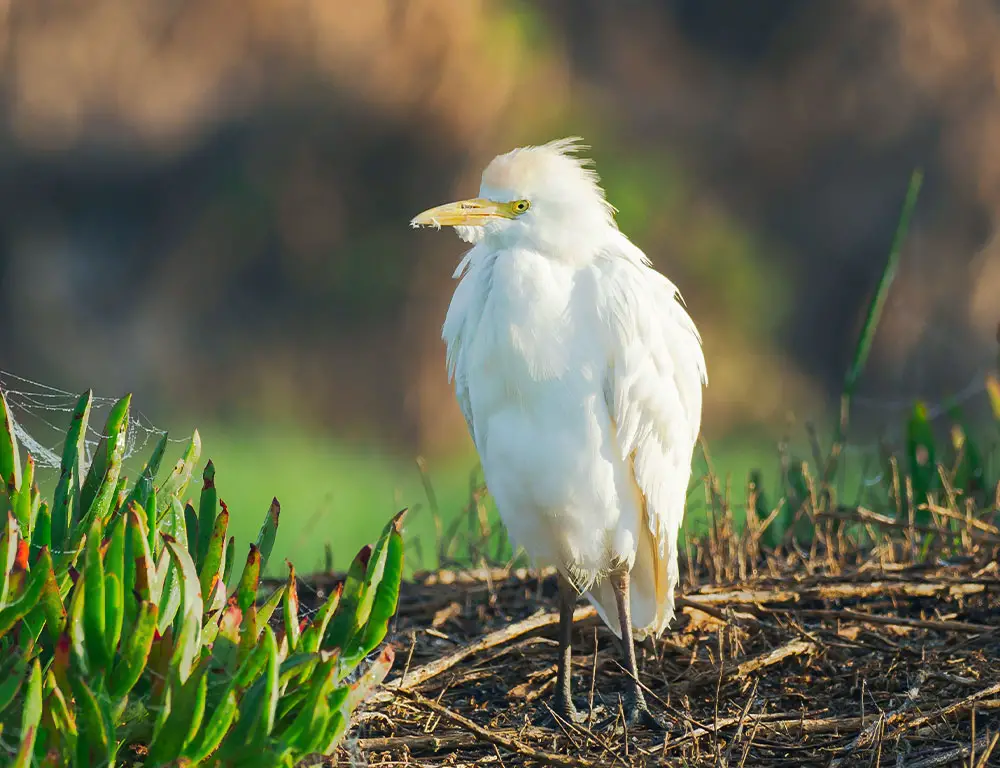
Identical Characteristics of the Intermediate Egret
The Intermediate Egret possesses several distinctive characteristics that set it apart from other egret species. Delve into this elegant bird’s unique traits and habits as we explore its identifying features.
Size and Plumage
Intermediate Egrets are medium-sized herons with a slender build, typically measuring around 60 to 72 centimeters in length. They exhibit a striking plumage pattern, featuring pristine white feathers on their body and wings, with contrasting dark legs and bill.
Yellow Bill
One of the key identifying features of the Intermediate Egret is its bright yellow bill, which is long, slender, and slightly curved. This distinctive bill shape is adapted for capturing prey, such as fish, frogs, and insects, in shallow water.
Long Neck
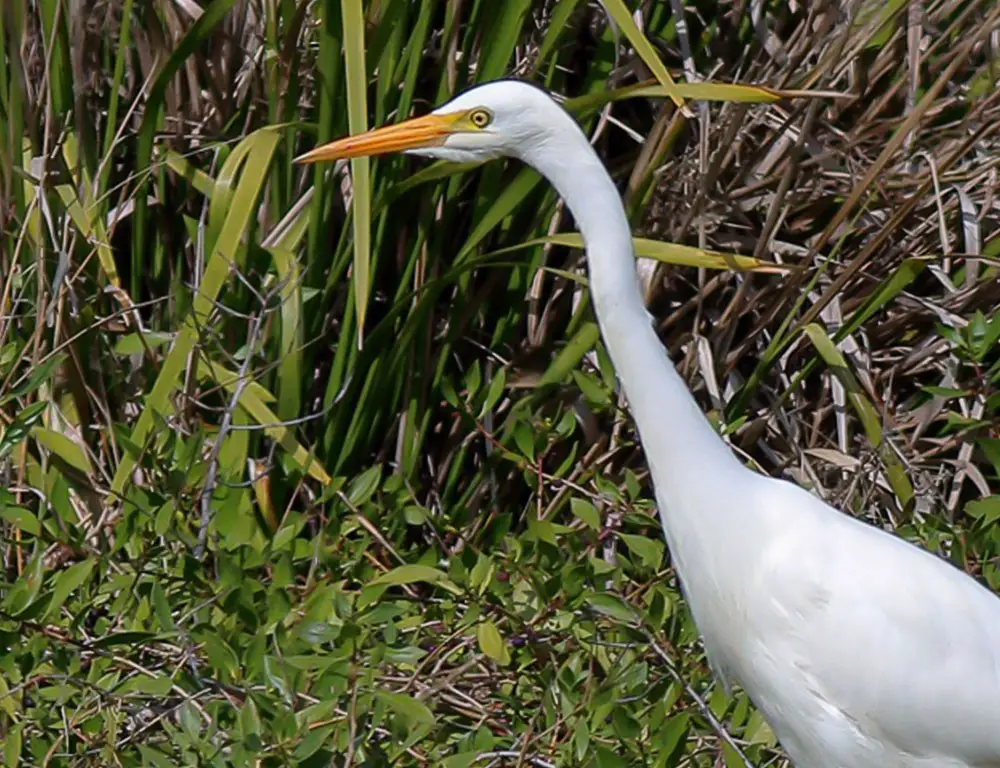
Intermediate Egrets have a long, graceful neck that extends their reach while foraging for food. This elongated neck, combined with their keen eyesight, enables them to spot prey hidden among aquatic vegetation or in muddy substrates.
Black Legs and Feet
Unlike some egret species with yellow or gray legs, Intermediate Egrets have black legs and feet, providing a stark contrast against their white plumage. These dark-colored legs are well-suited for wading through marshes and mudflats in search of prey.
Foraging Behavior
Intermediate Egrets are primarily piscivorous, meaning they feed predominantly on fish. They utilize their sharp bill to stab and capture fish, amphibians, crustaceans, and insects in shallow water bodies, including rivers, lakes, marshes, and coastal estuaries.
Habitat Preference
These egrets inhabit various wetland habitats, including freshwater marshes, tidal flats, rice paddies, and mangrove forests. They are adaptable birds thriving in natural and human-altered landscapes.
Breeding Colonies
Intermediate Egrets may congregate in large colonies during the breeding season, often alongside other heron and egret species. They build platform nests in trees or reed beds, raising their young and engaging in elaborate courtship displays to attract mates.
Taxonomy of the Intermediate Egret
| Taxonomy Level | Classification |
| Kingdom | Animalia |
| Phylum | Chordata |
| Class | Aves |
| Order | Pelecaniformes |
| Family | Ardeidae |
| Genus | Ardea |
| Species | Ardea intermedia |
Distribution of the Intermediate Egret
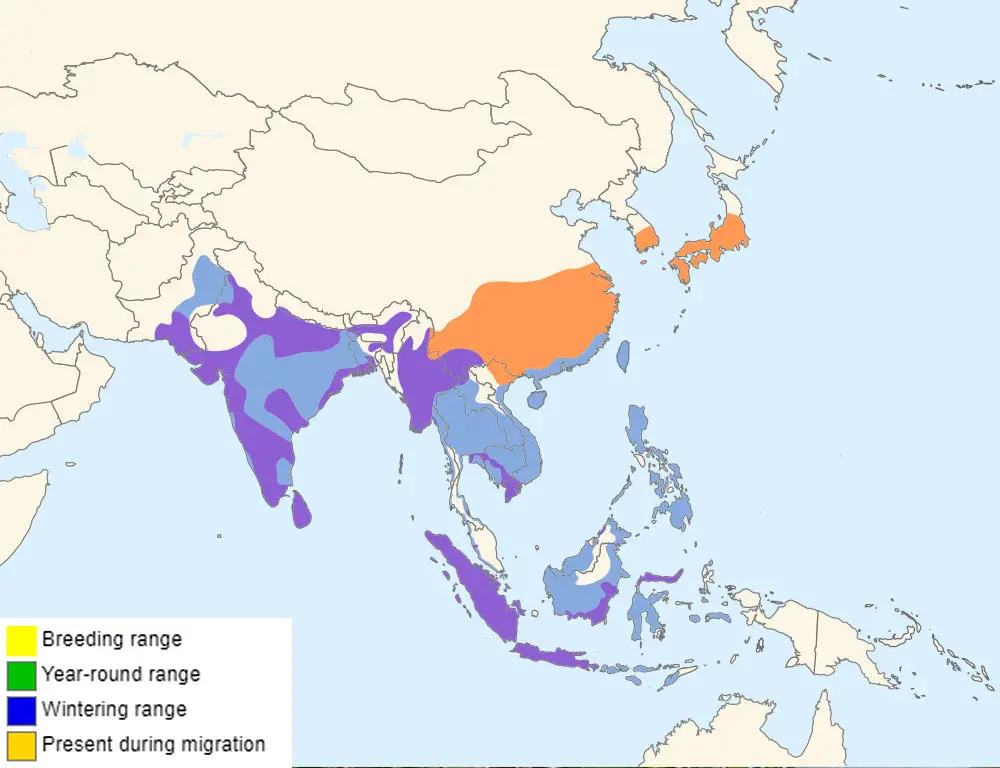
Intermediate Egrets are widely distributed across Asia, Africa, and Australia, inhabiting various wetland habitats such as freshwater marshes, estuaries, mangroves, and rice fields.
In some regions, they are migratory birds, with populations dispersing to breeding grounds during the breeding season and migrating to warmer areas during the non-breeding season.
Food Habits of the Intermediate Egret
Intermediate Egrets are opportunistic feeders, preying on a diverse array of aquatic and terrestrial organisms. Their diet primarily consists of fish, frogs, crustaceans, insects, and small reptiles.
They employ various foraging techniques, including standing motionless in shallow water and actively stalking prey while strolling or wading.
Nesting Habits of the Intermediate Egret
Intermediate Egrets typically nest in colonies, often alongside other heron and egret species, in trees or reed beds near water bodies.
They construct platform nests using twigs, branches, and other plant materials, lining them with softer ones like leaves and grass.
| Nesting Habit | Description |
| Nest Location | Intermediate Egrets typically nest in colonies alongside other heron and egret species. Nests are constructed in trees or reed beds near water bodies, providing access to food and nesting materials. |
| Nest Structure | The nests of Intermediate Egrets are platform-like structures made of twigs, branches, and plant materials. They are lined with softer materials such as leaves, grass, and feathers for added comfort and insulation. |
| Breeding Season | Breeding typically occurs during the wet season when food availability is abundant, varying by geographic location. |
| Courtship Displays | Breeding pairs engage in elaborate courtship displays, including aerial maneuvers, mutual preening, and vocalizations. |
| Egg Laying | Females lay a clutch of 3-5 eggs, which both parents incubate for approximately three weeks. |
| Parental Care | Both parents feed and care for the chicks after hatching until they fledge and become independent. |
Breeding Behavior of the Intermediate Egret
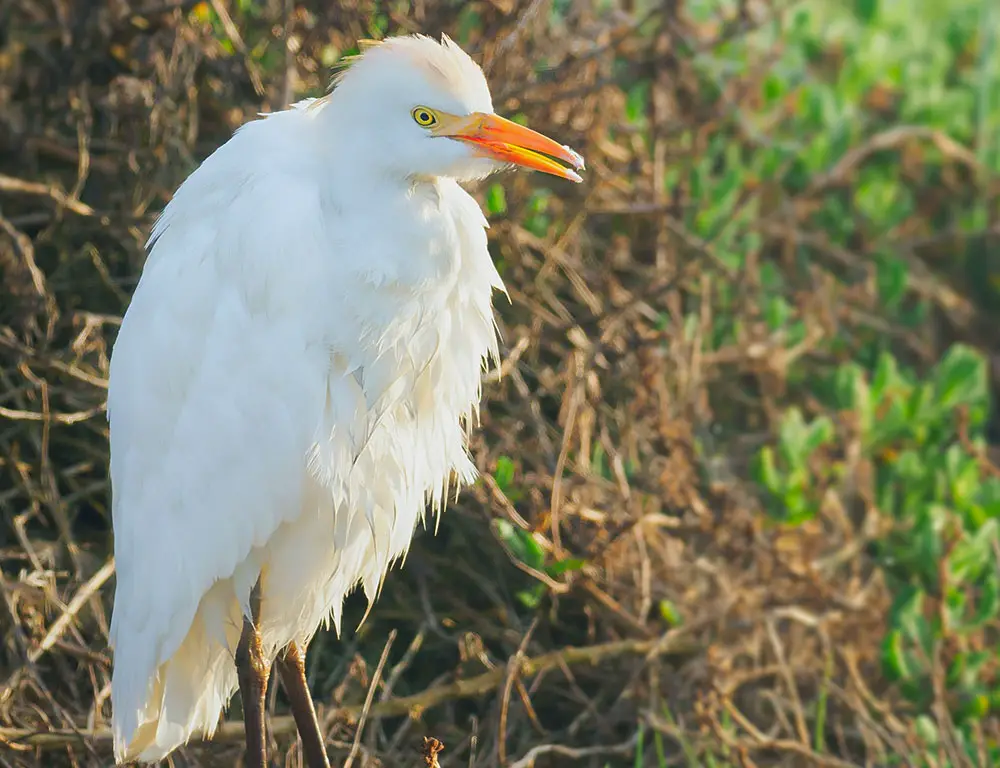
Breeding in Intermediate Egrets typically occurs during the wet season when food availability is abundant. Males establish territories and court females through elaborate displays and rituals.
Once pair bonds are formed, females lay a clutch of 3-5 eggs, which both parents incubate for about three weeks. After hatching, both parents feed and care for the chicks until they fledge.
Interactions with Humans and Economic Importance
Intermediate Egrets play critical ecological roles in wetland ecosystems by regulating prey populations and contributing to nutrient cycling. They also have cultural significance in some regions and may be featured in art, folklore, and traditional ceremonies.
Additionally, they support ecotourism activities, providing opportunities for birdwatching and nature-based tourism in wetland areas.
Research and Monitoring
Scientific research on Intermediate Egrets focuses on understanding their ecology, behavior, and population dynamics. Monitoring programs track population trends, breeding success, and habitat changes to inform conservation management strategies.
Collaborative efforts involving scientists, conservation organizations, and local communities are essential for ensuring the long-term survival of Intermediate Egrets and their wetland habitats.
Is the Intermediate Egret Endangered?
No, the Intermediate Egret is not considered endangered. The International Union for Conservation of Nature (IUCN) categorizes it as Least Concern.
However, like many wetland birds, it faces habitat loss, pollution, human disturbance, and climate change threats. Conservation efforts are essential to ensure the continued survival of the species and the preservation of its wetland habitats.
8 Interesting Facts About the Intermediate Egret
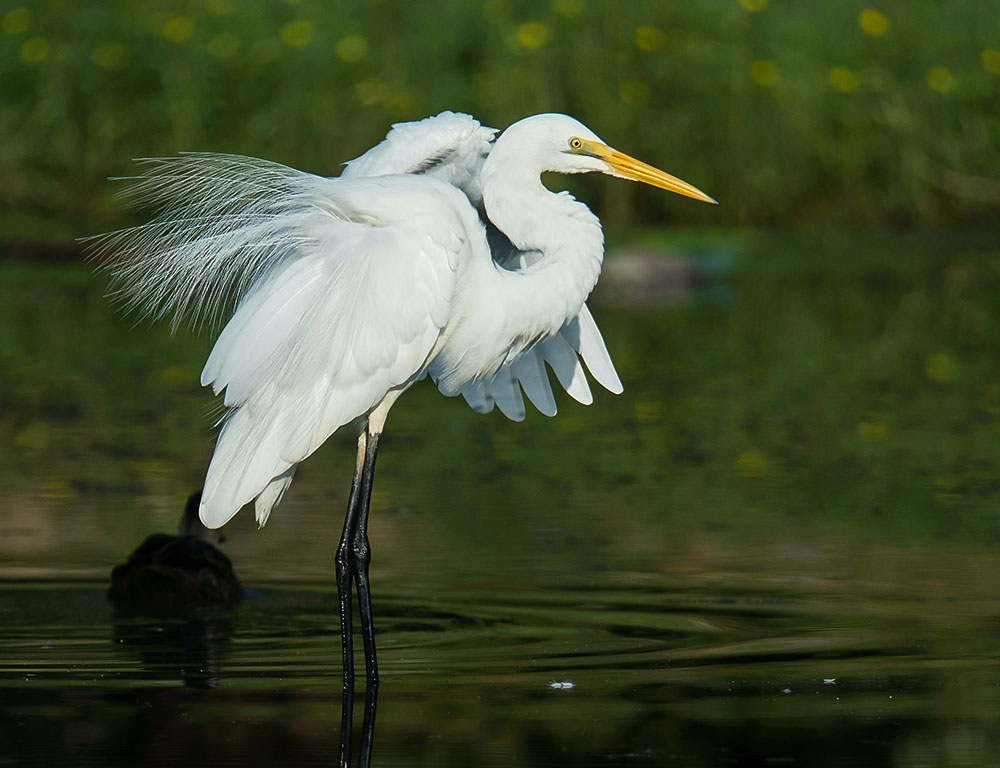
Embark on a journey of discovery as we uncover eight fascinating facts about the Intermediate Egret, a graceful inhabitant of wetland ecosystems worldwide.
1. Global Distribution
Intermediate Egrets have a wide distribution. They are found across Asia, Africa, and Australia and inhabit diverse wetland habitats such as marshes, rivers, lakes, and coastal estuaries.
2. Migratory Behavior
While some populations of Intermediate Egrets are sedentary, others undertake seasonal migrations, moving between breeding and non-breeding areas in response to changing environmental conditions.
3. Distinctive Plumage
These egrets boast striking plumage, with pristine white feathers adorning their body and wings, complemented by contrasting dark legs and bill. Their yellow bill adds a splash of color to their elegant appearance.
4. Foraging Techniques
Intermediate Egrets employ various foraging techniques to capture prey, including standing motionless in shallow water, patiently waiting for fish to approach, and actively stalking prey while walking or wading.
5. Colonial Nesters
Intermediate Egrets often nest in colonies during the breeding season, forming bustling communities alongside other heron and egret species. This colonial nesting behavior provides safety in numbers and facilitates social interactions.
6. Parental Care
Both parents play active roles in raising their offspring, sharing responsibilities such as incubating the eggs, feeding the chicks, and defending the nest from potential threats.
7. Vocalizations
While Intermediate Egrets are generally quiet birds, they may emit soft calls and croaks during courtship displays and territorial disputes. These vocalizations serve as communication signals within the breeding colony.
8. Ecological Importance
As top predators in wetland ecosystems, Intermediate Egrets help regulate prey populations and maintain the ecological balance of their habitats. Their presence is indicative of a healthy wetland environment.
FAQs
How tall is the Intermediate Egret?
Intermediate Egrets typically measure 60 to 70 centimeters (24 to 28 inches) in length and have a wingspan of approximately 90 to 100 centimeters (35 to 39 inches).
What is the lifespan of the Intermediate Egret?
The lifespan of an Intermediate Egret in the wild is typically around 10 to 15 years. However, some individuals may live longer in favorable conditions with access to abundant food and minimal threats.
Do Intermediate Egrets have any predators?
While Intermediate Egrets may face predation from larger birds of prey, such as eagles and hawks, as well as terrestrial predators like mammals and reptiles, their main defense mechanism is to remain vigilant and agile while foraging and nesting.
How do Intermediate Egrets communicate with each other?
Intermediate Egrets communicate with each other using a variety of vocalizations, including soft calls and croaks. These vocalizations maintain social cohesion within breeding colonies and signal territorial boundaries and mating readiness.
Conclusion
The Intermediate Egret is a testament to the resilience and adaptability of avian species in changing environments. Its graceful presence and versatile nature make it a symbol of elegance and resourcefulness in wetland habitats worldwide.
As we reflect on the Intermediate Egret’s role in ecosystems and its interactions with human activities, we are reminded of the importance of conservation efforts to safeguard its habitat and ensure its continued survival.
By protecting wetlands, reducing pollution, and promoting sustainable practices, we can help preserve the beauty and diversity of species like the Intermediate Egret for future generations to admire and appreciate.
Let us continue to admire and protect these magnificent birds, recognizing their significance as ambassadors of wetland ecosystems and as indicators of the health of our planet’s natural habitats. Keep your keen eyes on the sky to admire their beauty more.